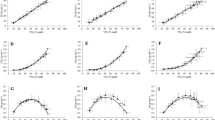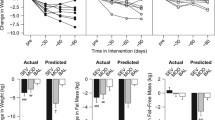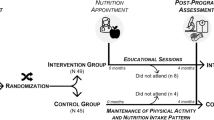Abstract
Purpose
Despite adaptive thermogenesis (AT) being studied as a barrier to weight loss (WL), few studies assessed AT in the resting energy expenditure (REE) compartment after WL maintenance. The aim of this study was twofold: (1) to understand if AT occurs after a moderate WL and if AT persists after a period of WL maintenance; and (2) if AT is associated with changes in body composition, hormones and energy intake (EI).
Methods
Ninety-four participants [mean (SD); BMI, 31.1(4.3)kg/m2; 43.0(9.4)y; 34% female] were randomized to intervention (IG, n = 49) or control groups (CG, n = 45). Subjects underwent a 1-year lifestyle intervention, divided in 4 months of an active WL followed by 8 months of WL maintenance. Fat mass (FM) and fat-free mass (FFM) were measured by dual-energy X-ray absorptiometry and REE by indirect calorimetry. Predicted REE (pREE) was estimated through a model using FM, FFM. EI was measured by the “intake-balance” method.
Results
For the IG, the weight and FM losses were − 4.8 (4.9) and − 11.3 (10.8)%, respectively (p < 0.001). A time–group interaction was found between groups for AT. After WL, the IG showed an AT of -85(29) kcal.d−1 (p < 0.001), and remained significant after 1 year [AT = − 72(31)kcal.d−1, p = 0.031]. Participants with higher degrees of restriction were those with an increased energy conservation (R = − 0.325, p = 0.036 and R = − 0.308, p = 0.047, respectively). No associations were found between diet adherence and AT. Following a sub-analysis in the IG, the group with a higher energy conservation showed a lower WL and fat loss and a higher initial EI.
Conclusion
AT in REE occurred after a moderate WL and remained significant after WL maintenance. More studies are needed to better clarify the mechanisms underlying the large variability observed in AT and providing an accurate methodological approach to avoid overstatements. Future studies on AT should consider not only changes in FM and FFM but also the FFM composition.

Similar content being viewed by others
References
Aronne LJ, Hall KD, Jakicic MJ, Leibel RL, Lowe MR, Rosenbaum M, Klein S (2021) Describing the weight-reduced state: physiology, behavior, and interventions. Obesity 29(S1):S9–S24. https://doi.org/10.1002/oby.23086
Fildes A, Charlton J, Rudisill C, Littlejohns P, Prevost AT, Gulliford MC (2015) Probability of an obese person attaining normal body weight: cohort study using electronic health records. Am J Public Health 105(9):e54-59. https://doi.org/10.2105/ajph.2015.302773
Muller MJ, Enderle J, Bosy-Westphal A (2016) Changes in energy expenditure with weight gain and weight loss in humans. Curr Obes Rep 5(4):413–423. https://doi.org/10.1007/s13679-016-0237-4
Leibel RL, Rosenbaum M, Hirsch J (1995) Changes in energy expenditure resulting from altered body weight. N Engl J Med 332(10):621–628. https://doi.org/10.1056/nejm199503093321001
Maclean PS, Bergouignan A, Cornier MA, Jackman MR (2011) Biology’s response to dieting: the impetus for weight regain. Am J Physiol Regul Integr Comp Physiol 301(3):R581-600. https://doi.org/10.1152/ajpregu.00755.2010
Nunes CL, Casanova N, Francisco R, Bosy-Westphal A, Hopkins M, Sardinha LB, Silva AM (2021) Does adaptive thermogenesis occur after weight loss in adults? A systematic review. Br J Nutr. https://doi.org/10.1017/S0007114521001094
Major GC, Doucet E, Trayhurn P, Astrup A, Tremblay A (2007) Clinical significance of adaptive thermogenesis. Int J Obes (Lond) 31(2):204–212. https://doi.org/10.1038/sj.ijo.0803523
Dulloo AG, Jacquet J, Montani JP, Schutz Y (2012) Adaptive thermogenesis in human body weight regulation: more of a concept than a measurable entity? Obesity Rev 13(Suppl 2):105–121. https://doi.org/10.1111/j.1467-789X.2012.01041.x
Nunes CL, Jesus F, Francisco R, Matias CN, Heo M, Heymsfield SB, Bosy-Westphal A, Sardinha LB, Martins P, Minderico CS, Silva AM (2021) Adaptive thermogenesis after moderate weight loss: magnitude and methodological issues. Eur J Nutr. https://doi.org/10.1007/s00394-021-02742-6
Fothergill E, Guo J, Howard L, Kerns JC, Knuth ND, Brychta R, Chen KY, Skarulis MC, Walter M, Walter PJ, Hall KD (2016) Persistent metabolic adaptation 6 years after “The Biggest Loser” competition. Obesity (Silver Spring, Md) 24(8):1612–1619. https://doi.org/10.1002/oby.21538
Johannsen DL, Knuth ND, Huizenga R, Rood JC, Ravussin E, Hall KD (2012) Metabolic slowing with massive weight loss despite preservation of fat-free mass. J Clin Endocrinol Metab 97(7):2489–2496. https://doi.org/10.1210/jc.2012-1444
Tremblay A, Royer MM, Chaput JP, Doucet E (2013) Adaptive thermogenesis can make a difference in the ability of obese individuals to lose body weight. Int J Obes (Lond) 37(6):759–764. https://doi.org/10.1038/ijo.2012.124
Gomez-Arbelaez D, Crujeiras AB, Castro AI, Martinez-Olmos MA, Canton A, Ordoñez-Mayan L, Sajoux I, Galban C, Bellido D, Casanueva FF (2018) Resting metabolic rate of obese patients under very low calorie ketogenic diet. Nutr Metab (Lond) 15:18. https://doi.org/10.1186/s12986-018-0249-z
Marlatt KL, Redman LM, Burton JH, Martin CK, Ravussin E (2017) Persistence of weight loss and acquired behaviors 2 y after stopping a 2-y calorie restriction intervention. Am J Clin Nutr 105(4):928–935. https://doi.org/10.3945/ajcn.116.146837
Novaes Ravelli M, Schoeller DA, Crisp AH, Shriver T, Ferriolli E, Ducatti C, Marques de Oliveira MR (2019) Influence of energy balance on the rate of weight loss throughout one year of Roux-en-Y gastric bypass: a doubly labeled water study. Obes Surg 29(10):3299–3308. https://doi.org/10.1007/s11695-019-03989-z
Wolfe BM, Schoeller DA, McCrady-Spitzer SK, Thomas DM, Sorenson CE, Levine JA (2018) Resting metabolic rate, total daily energy expenditure, and metabolic adaptation 6 months and 24 months after bariatric surgery. Obesity (Silver Spring) 26(5):862–868. https://doi.org/10.1002/oby.22138
Martins C, Gower BA, Hill JO, Hunter GR (2020) Metabolic adaptation is not a major barrier to weight-loss maintenance. Am J Clin Nutr. https://doi.org/10.1093/ajcn/nqaa086
Rosenbaum M, Hirsch J, Gallagher DA, Leibel RL (2008) Long-term persistence of adaptive thermogenesis in subjects who have maintained a reduced body weight. Am J Clin Nutr 88(4):906–912. https://doi.org/10.1093/ajcn/88.4.906
Hopkins M, Gibbons C, Caudwell P, Hellstrom PM, Naslund E, King NA, Finlayson G, Blundell JE (2014) The adaptive metabolic response to exercise-induced weight loss influences both energy expenditure and energy intake. Eur J Clin Nutr 68(5):581–586. https://doi.org/10.1038/ejcn.2013.277
Bosy-Westphal A, Schautz B, Lagerpusch M, Pourhassan M, Braun W, Goele K, Heller M, Glüer CC, Müller MJ (2013) Effect of weight loss and regain on adipose tissue distribution, composition of lean mass and resting energy expenditure in young overweight and obese adults. Int J Obes (Lond) 37(10):1371–1377. https://doi.org/10.1038/ijo.2013.1
Silva AM, Nunes CL, Matias CN, Jesus F, Francisco R, Cardoso M, Santos I, Carraça EV, Silva MN, Sardinha LB, Martins P, Minderico CS (2020) Champ4life study protocol: a one-year randomized controlled trial of a lifestyle intervention for inactive former elite athletes with overweight/obesity. Nutrients. https://doi.org/10.3390/nu12020286
Riebe D, Ehrman JK, Liguori G, Magal M American College of Sports M (2018) ACSM’s guidelines for exercise testing and prescription
Silva AM, Nunes CL, Jesus F, Francisco R, Matias CN, Cardoso M, Santos I, Carraça EV, Finlayson G, Silva MN, Dickinson S, Allison D, Minderico CS, Martins P, Sardinha LB (2021) Effectiveness of a lifestyle weight-loss intervention targeting inactive former elite athletes: the Champ4Life randomised controlled trial. Br J Sports Med 56:394–402. https://doi.org/10.1136/bjsports-2021-104212
World Medical Association (2013) Declaration of Helsinki: ethical principles for medical research involving human subjects. Jama 310(20):2191–2194
Marques M, Hagger M (2019) Classification of techniques used in self-determination theory-based interventions in health contexts: an expert consensus study. Motiv Sci. https://doi.org/10.31234/osf.io/z9wqu
Park YW, Heymsfield SB, Gallagher D (2002) Are dual-energy X-ray absorptiometry regional estimates associated with visceral adipose tissue mass? Int J Obes Relat Metab Disord 26(7):978–983. https://doi.org/10.1038/sj.ijo.0801982
Sherman M, Fan B, Borrud LG, Powers CL, Shepherd JA (2011) Accuracy and precision of the hologic reflection technique for obese whole body scan analysis. J Clin Densitom 14:165
Weir JB (1949) New methods for calculating metabolic rate with special reference to protein metabolism. J Physiol 109(1–2):1–9
Compher C, Frankenfield D, Keim N, Roth-Yousey L (2006) Best practice methods to apply to measurement of resting metabolic rate in adults: a systematic review. J Am Diet Assoc 106(6):881–903. https://doi.org/10.1016/j.jada.2006.02.009
Weststrate JA (1993) Resting metabolic rate and diet-induced thermogenesis: a methodological reappraisal. Am J Clin Nutr 58(5):592–601. https://doi.org/10.1093/ajcn/58.5.592
Thomas DM, Bouchard C, Church T, Slentz C, Kraus WE, Redman LM, Martin CK, Silva AM, Vossen M, Westerterp K, Heymsfield SB (2012) Why do individuals not lose more weight from an exercise intervention at a defined dose? An energy balance analysis. Obes Rev 13(10):835–847. https://doi.org/10.1111/j.1467-789X.2012.01012.x
Merril A, Watt B (1973) Energy value of foods, basis and derivation. Agriculture Handbook No 74 Washington, DC, ARS United States Department of Agriculture 2
Dulloo AG, Jacquet J (1999) The control of partitioning between protein and fat during human starvation: its internal determinants and biological significance. Br J Nutr 82(5):339–356. https://doi.org/10.1017/s0007114599001580
Rosenbaum M, Ravussin E, Matthews DE, Gilker C, Ferraro R, Heymsfield SB, Hirsch J, Leibel RL (1996) A comparative study of different means of assessing long-term energy expenditure in humans. Am J Physiol 270(3 Pt 2):R496-504. https://doi.org/10.1152/ajpregu.1996.270.3.R496
Shook RP, Hand GA, O’Connor DP, Thomas DM, Hurley TG, Hébert JR, Drenowatz C, Welk GJ, Carriquiry AL, Blair SN (2018) Energy intake derived from an energy balance equation, validated activity monitors, and dual X-ray absorptiometry can provide acceptable caloric intake data among young adults. J Nutr 148(3):490–496. https://doi.org/10.1093/jn/nxx029
Racette SB, Das SK, Bhapkar M, Hadley EC, Roberts SB, Ravussin E, Pieper C, DeLany JP, Kraus WE, Rochon J, Redman LM (2012) Approaches for quantifying energy intake and %calorie restriction during calorie restriction interventions in humans: the multicenter CALERIE study. Am J Physiol Endocrinol Metab 302(4):E441-448. https://doi.org/10.1152/ajpendo.00290.2011
Bonafiglia JT, Nelms MW, Preobrazenski N, LeBlanc C, Robins L, Lu S, Lithopoulos A, Walsh JJ, Gurd BJ (2018) Moving beyond threshold-based dichotomous classification to improve the accuracy in classifying non-responders. Physiol Rep 6(22):e13928. https://doi.org/10.14814/phy2.13928
Martins C, Roekenes J, Gower BA, Hunter GR (2021) Metabolic adaptation is associated with less weight and fat mass loss in response to low-energy diets. Nutr Metab 18(1):60. https://doi.org/10.1186/s12986-021-00587-8
Martins C, Roekenes J, Salamati S, Gower BA, Hunter GR (2020) Metabolic adaptation is an illusion, only present when participants are in negative energy balance. Am J Clin Nutr 112(5):1212–1218. https://doi.org/10.1093/ajcn/nqaa220
Painter SL, Ahmed R, Hill JO, Kushner RF, Lindquist R, Brunning S, Margulies A (2017) What matters in weight loss? An in-depth analysis of self-monitoring. J Med Internet Res 19(5):e160. https://doi.org/10.2196/jmir.7457
Karl JP, Roberts SB, Schaefer EJ, Gleason JA, Fuss P, Rasmussen H, Saltzman E, Das SK (2015) Effects of carbohydrate quantity and glycemic index on resting metabolic rate and body composition during weight loss. Obesity (Silver Spring) 23(11):2190–2198. https://doi.org/10.1002/oby.21268
Byrne NM, Sainsbury A, King NA, Hills AP, Wood RE (2018) Intermittent energy restriction improves weight loss efficiency in obese men: the MATADOR study. Int J Obes (Lond) 42(2):129–138. https://doi.org/10.1038/ijo.2017.206
Redman LM, Heilbronn LK, Martin CK, de Jonge L, Williamson DA, Delany JP, Ravussin E (2009) Metabolic and behavioral compensations in response to caloric restriction: implications for the maintenance of weight loss. PLoS ONE 4(2):e4377. https://doi.org/10.1371/journal.pone.0004377
McNeil J, Schwartz A, Rabasa-Lhoret R, Lavoie JM, Brochu M, Doucet É (2015) Changes in leptin and peptide YY do not explain the greater-than-predicted decreases in resting energy expenditure after weight loss. J Clin Endocrinol Metab 100(3):E443-452. https://doi.org/10.1210/jc.2014-2210
Müller MJ, Enderle J, Bosy-Westphal A (2016) Changes in energy expenditure with weight gain and weight loss in humans. Curr Obes Rep 5(4):413–423. https://doi.org/10.1007/s13679-016-0237-4
Tam CS, Rigas G, Heilbronn LK, Matisan T, Probst Y, Talbot M (2016) Energy adaptations persist 2 years after sleeve gastrectomy and gastric bypass. Obes Surg 26(2):459–463. https://doi.org/10.1007/s11695-015-1972-4
Coupaye M, Bouillot JL, Coussieu C, Guy-Grand B, Basdevant A, Oppert JM (2005) One-year changes in energy expenditure and serum leptin following adjustable gastric banding in obese women. Obes Surg 15(6):827–833. https://doi.org/10.1381/0960892054222768
Browning MG, Rabl C, Campos GM (2017) Blunting of adaptive thermogenesis as a potential additional mechanism to promote weight loss after gastric bypass. Surg Obes Relat Dis 13(4):669–673. https://doi.org/10.1016/j.soard.2016.11.016
Müller MJ, Enderle J, Pourhassan M, Braun W, Eggeling B, Lagerpusch M, Glüer CC, Kehayias JJ, Kiosz D, Bosy-Westphal A (2015) Metabolic adaptation to caloric restriction and subsequent refeeding: the minnesota starvation experiment revisited. Am J Clin Nutr 102(4):807–819. https://doi.org/10.3945/ajcn.115.109173
Bettini S, Bordigato E, Fabris R, Serra R, Dal Pra C, Belligoli A, Sanna M, Compagnin C, Foletto M, Prevedello L, Fioretto P, Vettor R, Busetto L (2018) Modifications of resting energy expenditure after sleeve gastrectomy. Obes Surg 28(8):2481–2486. https://doi.org/10.1007/s11695-018-3190-3
Silva AM, Santos DA, Matias CN, Minderico CS, Schoeller DA, Sardinha LB (2013) Total energy expenditure assessment in elite junior basketball players: a validation study using doubly labeled water. J Strength Cond Res 27(7):1920–1927. https://doi.org/10.1519/JSC.0b013e31827361eb
Blundell J, King N, Bryant E (2005) Interactions among physical activity food choice and appetite control: health message in physical activity and diet. Taylor & Francis, London
Melby CL, Paris HL, Foright RM, Peth J (2017) Attenuating the biologic drive for weight regain following weight loss: must what goes down always go back up? Nutrients. https://doi.org/10.3390/nu9050468
de Jonge L, Bray GA, Smith SR, Ryan DH, de Souza RJ, Loria CM, Champagne CM, Williamson DA, Sacks FM (2012) Effect of diet composition and weight loss on resting energy expenditure in the POUNDS LOST study. Obesity (Silver Spring) 20(12):2384–2389. https://doi.org/10.1038/oby.2012.127
Swinton PA, Hemingway BS, Saunders B, Gualano B, Dolan E (2018) A Statistical framework to interpret individual response to intervention: paving the way for personalized nutrition and exercise prescription. Front Nutr. https://doi.org/10.3389/fnut.2018.00041
Laine MK, Eriksson JG, Kujala UM, Kaprio J, Loo BM, Sundvall J, Bäckmand HM, Peltonen M, Jula A, Sarna S (2016) Former male elite athletes have better metabolic health in late life than their controls. Scand J Med Sci Sports 26(3):284–290. https://doi.org/10.1111/sms.12442
Griffin JR, Maxwell TM, Griffin L (2016) The prevalence and consequences of obesity in athletes. Curr Orthop Pract 27(2):129–134. https://doi.org/10.1097/bco.0000000000000346
Dutton GR, Kim Y, Jacobs DR Jr, Li X, Loria CM, Reis JP, Carnethon M, Durant NH, Gordon-Larsen P, Shikany JM, Sidney S, Lewis CE (2016) 25-year weight gain in a racially balanced sample of U.S. adults: the CARDIA study. Obesity (Silver Spring) 24(9):1962–1968. https://doi.org/10.1002/oby.21573
Provencher MT, Chahla J, Sanchez G, Cinque ME, Kennedy NI, Whalen J, Price MD, Moatshe G, LaPrade RF (2018) Body mass index versus body fat percentage in prospective national football league athletes: overestimation of obesity rate in athletes at the national football league scouting combine. J Strength Cond Res 32(4):1013–1019. https://doi.org/10.1519/jsc.0000000000002449
Müller MJ, Heymsfield SB, Bosy-Westphal A (2021) Are metabolic adaptations to weight changes an artefact? Am J Clin Nutr. https://doi.org/10.1093/ajcn/nqab184
Acknowledgements
The authors express their gratitude to all the participants involved in this study.
Funding
The Champ4life program was financially supported by the Portuguese Institute of Sports and Youth and by the International Olympic Committee, under the Olympic Solidarity Promotion of the Olympic Values Unit (Sports Medicine and Protection of Clean Athletes Programme). The program was also supported by national funding from the Portuguese Foundation for Science and Technology within the R&D units UIDB/00447/2020. C.L.N., R.F. and F.J. were supported with a PhD scholarship from the Portuguese Foundation for Science and Technology (SFRH/BD/143725/2019 and 2020.05397.BD and 2021.07122.BD, respectively).
Author information
Authors and Affiliations
Contributions
CLN: participated in the conceptualization, methodology, formal analysis, data curation and writing the first draft; FJ, RF: contributed to preparation, visualization and reviewing and editing. MH, LBS, PM and CSM: supervised and contributed to reviewing and editing, Supervision; AMS: participated in the conceptualization, methodology, supervision, funding acquisition, reviewing and editing. All authors have read and approved the final version of the manuscript.
Corresponding author
Ethics declarations
Conflict of interest
The authors reported no conflicts of interest.
Rights and permissions
About this article
Cite this article
Nunes, C.L., Jesus, F., Francisco, R. et al. Effects of a 4-month active weight loss phase followed by weight loss maintenance on adaptive thermogenesis in resting energy expenditure in former elite athletes. Eur J Nutr 61, 4121–4133 (2022). https://doi.org/10.1007/s00394-022-02951-7
Received:
Accepted:
Published:
Issue Date:
DOI: https://doi.org/10.1007/s00394-022-02951-7




